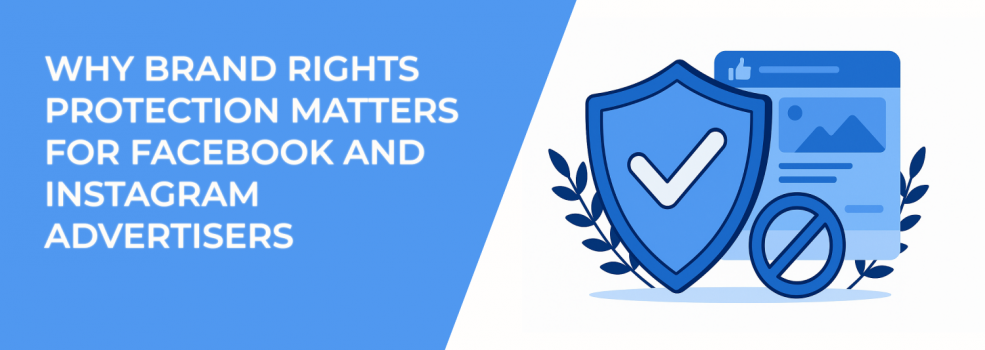If you advertise on Facebook or Instagram, you know how much effort goes into creating campaigns that build awareness, drive clicks, and convert customers. But what happens when counterfeiters, impersonators, or scammers try to hijack that effort?
This is where Brand Rights Protection comes into play. It’s Meta’s dedicated tool for businesses with registered trademarks that helps you protect your intellectual property and brand reputation across Facebook and Instagram. And if you’re running ads, you can’t afford to ignore it.
Why Ignoring Brand Protection Can Hurt Your Ads
Facebook and Instagram offer scale that few platforms can match. Billions of people scroll through feeds, stories, and reels every day. That reach is powerful, but it also attracts bad actors.
Here’s what advertisers commonly face:
-
Counterfeit shops running ads with your brand name or logo.
-
Fake profiles or Pages impersonating your company and engaging with your audience.
-
Stolen content — product photos, videos, or even ad creatives — repurposed to mislead customers.
Now imagine this: you’re running a paid campaign to promote your new product launch. Meanwhile, a scammer uses your images in their own ad, offering fake discounts that lead to fraudulent sites. Customers get confused, click the wrong ad, and lose trust in your business. The damage isn’t just financial — it’s reputational.
Would you let competitors run ads under your brand’s name without fighting back?
What Brand Rights Protection Actually Does
Once approved for access, Brand Rights Protection is available in Meta Business Suite. Think of it as your central dashboard for defending your intellectual property across Meta technologies.
Here’s what you can do:
-
Search and monitor — Find infringing ads, posts, Pages, accounts, and even items listed on Marketplace or Shops.
-
File takedowns — Submit requests when you find counterfeit, impersonation, or trademark/copyright violations.
-
Upload reference images — Give the system visual examples (logos, product photos, packaging) to proactively detect misuse.
-
Add trademarks — Link registered trademarks directly to your account so you can take swift action.
-
Track results — Use reports and metrics to monitor takedowns and see how the tool is protecting your brand.
It’s not a one-time process. The more data you provide — images, trademarks, allow lists, takedown requests — the smarter the system becomes at identifying threats.
Why Advertisers Should Care
For many marketers, protecting a brand is seen as a legal matter, but for advertisers, it’s also a performance issue. Your campaigns only work if people trust the ads they see.
Here’s why Brand Rights Protection matters specifically for advertisers on Facebook and Instagram:
-
Preserve credibility: Fake ads erode customer trust, making audiences skeptical of your real campaigns.
-
Protect ad spend: Why let counterfeiters siphon off impressions or clicks you paid for?
-
Safeguard customer journeys: Prevent potential buyers from being misled by fraudulent promotions.
-
Reduce risk: By taking down infringers, you minimize the chances of being tied to scams or deceptive practices.
Advertising without brand protection is like leaving your shop’s doors unlocked during peak season. Someone else will try to walk in and cash out.
For a broader perspective on making campaigns more effective, check out Facebook Ads Targeting Updates: How To Adapt in 2025.
Setting Up Brand Rights Protection: Step by Step
Getting started is straightforward, but setup requires a few key steps. Once Meta approves your access, here’s the process:
-
Accept Terms of Use
Before anything else, you’ll need to review and agree to the terms. -
Add IP Reviewers
Assign team members who will handle trademark enforcement. Only those designated as reviewers can file takedowns. -
Add Registered Trademarks
Even if you submitted proof during your application, you’ll need to add them again in your Reference Library. Without at least one trademark, you can’t file takedowns. -
Upload Reference Images (recommended)
Add product photos, packaging, and logos. Meta will proactively scan ads and content for matches, which you can review in the Matches tab. -
Add Allowed Accounts (recommended)
Create an “allow list” for your official Pages and trusted partners. This keeps them out of your search results and prevents wasted time reviewing legitimate content.
Completing all five steps ensures the system works at full strength. Skipping steps limits your ability to detect and act quickly.
Best Practices for Advertisers
Want to make Brand Rights Protection work harder for your campaigns? Keep these best practices in mind:
-
Start broad when searching: Begin with your brand name. Then refine by product type, spelling variations, or keywords like “offer,” “discount,” or “sale.”
-
Use image search for suspicious content: See an ad that looks like yours? Upload a screenshot and find exact or similar matches.
-
Submit full-size, clear images: Cropped or low-resolution screenshots reduce the chances of detecting misuse.
-
Leverage the Matches feature: After filing reports, Meta will scan for content using similar text and images, saving you time on discovery.
-
Build a strong allow list: Add affiliates, resellers, and trusted accounts so your results focus only on potential threats.
Curious about how these practices tie into long-term growth strategies? Explore Mastering Lead Generation in 2025: Top Tactics for Success.
New Updates: Scam Ad Reporting and Simplified Takedowns
Meta recently expanded the tool to meet evolving advertiser needs. Two updates stand out:
-
Expanded Scam Ad Reporting
Previously, you could only report ads that directly used your trademarks or copyrighted material. Now, all Brand Rights Protection accounts can report scam ads at scale — even if they don’t contain your IP but still exploit your brand name. -
Simplified Takedown Requests
Filing a request is now faster and more intuitive. You can filter reports by violation type (Copyright, Counterfeit, Impersonation, Trademark) and search using keywords, IDs, or email report IDs.
These updates save advertisers valuable time while strengthening defenses against scammers.
If you’ve ever had ads rejected or campaigns unexpectedly paused, you’ll also want to read Understanding Facebook Ad Statuses: Common Issues and How to Fix Them.
The Bigger Picture: Protecting Brand Trust
At the end of the day, advertising is about trust. Customers click and convert when they believe in the authenticity of your message. If fake ads flood their feeds, even the best campaign can lose its impact.
By using Brand Rights Protection, you’re not just defending your trademarks. You’re protecting the investments you make in advertising, the experience of your customers, and the long-term credibility of your business.
Your ads deserve a clean playing field. Don’t let counterfeiters and impersonators decide how your brand is seen.

